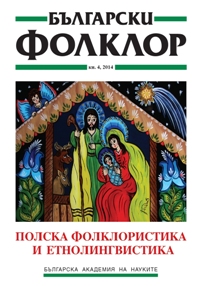Съвременни народни обичаи и обреди в Полша. Избрани проблеми
Contemporary Folk Customs and Rites in Poland. Selected Тopics
Author(s): Teresa SmolińskaSubject(s): Customs / Folklore
Published by: Институт за етнология и фолклористика с Етнографски музей при БАН
Keywords: customs and rites; Upper Silesia; hybridisation of contemporary culture; popular culture; integrative function
Summary/Abstract: Complexity of aspects related to the existence of traditional folk customs and rites in the contemporary culture of Poland makes the researcher select only some of the cultural facts. Influence of popular culture leads directly to desemiotisation, dominance of aesthetics, degradation of primary symbolism and as a result to unification and trivialisation of native cultural phenomena. The authoress focuses only on those customs and rites that have retained their regional dimension though they certainly couldn’t have escaped the influence of foreign culture. She is interested in the selected yearly events related to the annual vegetative cycle and the liturgy of the Catholic Church, which are characterised by magic and religious symbols and signs, and to the family life concentrated on the wedding and marriage. The regionally-marked examples were drawn from one region, i.e. Upper Silesia in Poland, and were collected mainly among native population, namely Silesians. The need to take into account diverse origins of a particular phenomenon is the sine qua non condition of examining Upper Silesia from the point of view of the cultural researcher. Ethnical autonomy of the Silesians can still be seen in many cultural facts which either result from long-lasting impact of Polish, Czech, Moravian and western culture, mainly the German one, or these are new cultural standards adopted from the popular western culture in recent years. Local people get used to them quickly and regard them as their own also “thanks to” the German minority and priests. In this context the authoress distinguishes between traditional relic forms and new ones of German origin, pointing especially to searching for gifts brought by the Easter Bunny (Osterhase), Advent or Christmas markets (Weihnachtsmarkt, Christkindlesmarkt), hen parties dominated with a pre-wedding cult of penis, weddings (wedding ceremonies) conducted on the stage and the so-called dream weddings. It is hard to reach a limit of eccentric ideas showing a transition from the rite and ritual to a theatre: there are many trivialised signs of a traditional rite, much attention is paid to folk ‘authenticity’ and there are numerous examples of folklorisation of second degree. An integrative function of such regional cultural heritage is very visible here. These new forms of annual and family rites in Upper Silesia are also an example of increasingly popular relations with German burgher culture and trivialised signs of regional identity, which are regarded by the authoress as the hybridisation of contemporary culture.
Journal: Български фолклор
- Issue Year: XL/2014
- Issue No: 4
- Page Range: 376-398
- Page Count: 23
- Content File-PDF

